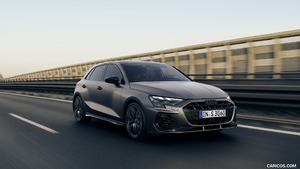2014 Porsche 911 GT3
The Sportiest 911 of Them All
The most sporting 911 with a naturally-aspirated power unit is all set and ready to take up new challenges: Even more powerful, faster and more dynamic than ever before, the new 911 GT3 is about to prove its enhanced potential as of May 2009.
As usual, a wide range of know-how gained in motorsport has gone directly into the development of this outstanding sports car, making the new GT3 a supreme performer not only on the road, but also on the track.
The Porsche 911 GT3 now reaches an even higher standard in its two main qualities: power and driving dynamics. Maximum output of the naturally-aspirated six-cylinder now increased in size to 3.8 litres is 435 bhp (320 kW), up 20 bhp over the previous model. In particular, the flat-six power unit carefully upgraded for even more muscle and performance offers a significant increase in torque at medium engine speeds very noticeable above all in everyday use.
Road performance of the new GT3 has also been enhanced once again, with the car accelerating to 100 km/h in 4.1 seconds and reaching 160 km/h in 8.2 seconds. Top speed is 312 km/h or 193 mph, and both fuel consumption as well as exhaust emissions have been further reduced.
Striking, unique design with a new rear wing
In its unique and truly outstanding design, the new 911 GT3 stands out from the start as a thoroughbred production sports car and a production-based racing car all in one. Even at very first sight, the new GT3 clearly shows its qualities to the connoisseur, the new cooling air outlet bordering on the front apron and the front lid and positioned between the bi-xenon headlights now featured for the first time as standard offering optimised thermal balance. And as a special feature the central outlet is covered by a grid on top, just like the three large air intakes in the lower section of the front bumper previously open to the outside without any kind of cover.
The rear end of the new GT3 stands out even more significantly both from the previous model and from the production 911, with the newly designed engine lid featuring modified, grid-clad air outlets stretching from one side to the other between the LED rear light clusters.
The most characteristic feature of the 911 GT3 is the rear wing fitted in position as a regular highlight on all GT3s over the years. Completely re-designed, the wing now extends beyond the support bars in the same look as on the racing versions of the GT3. The side ends of the wing – the sideplates – are connected with the wing completely from front to rear and proudly bear the designation "3.8" as reference to the new power unit – and as a reminiscence to the legendary 911 RS 3.8 back in 1993.
Beneath the wing two spade-like scoops serve as air intakes, supplying the engine with a forced air flow according to the ram air principle, thus improving both the intake of combustion air and the engine cooling effect.
Ground effect: downforce more than doubled
This upgrade of the GT3 in its design and contours serves above all to optimise the car’s aerodynamics: The modifications increase downforce both on the front and rear axle, ensuring more than twice as much downforce overall as on the former GT3. As a result, the new GT3 now offers even better grip and stability at high speeds.
The aerodynamic qualities of the new 911 GT3 are also enhanced significantly with body height lowered by approximately 30 millimetres or almost 1.2" versus the current 911 Carrera. First, this reduces the frontal area of the car and minimises air resistance accordingly. Second, the lower body reduces the flow of air beneath the car, once again increasing downforce accordingly.
Like the current 911 Carrera, the 911 GT3 comes with an extra-large underfloor cover for superior aerodynamics. Appropriate air ducts in the rear of the underfloor cover serve at the same time to cool the rear brakes.
High-performance power unit with upgraded VarioCam
Once again, the power unit of the new 911 GT3 proves the great potential the six-cylinder boxer still has to offer: With maximum engine speed increased from 8,400 to 8,500 rpm the new 911 GT3 is again one of the top performers in terms of speed and dynamic engine qualities. Specific output of 114.6 bhp (84.3 kW) per litre exceeds that of most competitors, in some cases by far.
To provide qualities of this calibre, the engine must not only be able to run at very high speeds, but must also have a very good and efficient charge cycle. Precisely this is why VarioCam on the new 911 GT3 features infinite adjustment not only of the intake, but also of the outlet camshafts.
Apart from increasing both engine power and torque, this also ensures cleaner emissions outperforming the EU5 standard and thus qualifying the GT3 for full, unrestricted homologation.
In its basic configuration the six-cylinder power unit of the new GT3 is a further development of the engine originally conceived for the 911 GT1. Its characteristic features are classic dry sump lubrication with an external oil tank, titanium connecting rods, forged pistons, cup tappets fully suited for very high engine speeds, and a variable intake system with two resonance flaps.
An appropriately designed exhaust system likewise serves to minimise resistance in the charge cycle process. The gas mixture leaving the engine first flows through two fan-type manifolds reducing flow resistance and ensuring a better mixing process than standard manifolds. This allows more effective pre-treatment of the raw emissions before they are converted further downstream in the catalyst.
Behind the two catalysts the exhaust gas flows on into two pre-silencers activated by map-controlled flaps. Still closed when the engine is started, the flaps open up under increasing power and the exhaust gas then flows directly into the main silencer. Naturally, the new 911 GT3 fulfils the noise limits prescribed by law in both cases – and at the same time this special configuration gives the engine its very characteristic six-cylinder rumble.
Six-speed gearbox with upshift signal
As before, power is transmitted on the 911 GT3 exclusively by a manual six-speed gearbox. An upshift display flashing on in the rev counter shortly before the engine reaches the appropriate speed helps the driver shift gears at exactly the right points. And taking the driver’s reaction time into account, the display comes on earlier in the lower gears and later in the upper gears.
The very sporting gearshift transmission on the current generation of the 911 Carrera guarantees an extremely dynamic shift process with short gear lever travel, particularly because in this case it is combined with a short lever ratio at the transmission entry point specific to the GT3. This makes the overall transmission ratio in the new 911 GT3 22 per cent shorter than in the "regular" Carrera models.
Since the 911 GT3 was also developed specifically for track racing, the transmission ratios may be varied individually as required by means of exchangeable gears and gear sets. This option is however intended only for use of the car on race tracks reserved exclusively for this purpose.
New: PSM with motorsport set-up
A significant highlight in developing the 911 GT3 to an even higher standard was to increase driving dynamics while keeping the weight of the car unchanged: Despite its technical features and qualities enhanced to an even higher standard, the GT3 therefore retains its former weight of just 1,395 kg or 3,076 lb.
For the first time the 911 GT3 now comes with a particularly sporting and dynamic version of PSM Porsche Stability Management supporting the driver in his reactions and thus allowing even the professional motorsport enthusiast to achieve faster lap times with PSM than without. To make this possible, the driver is able to deactivate SC Stability Control and TC Traction Control separately from one another in individual steps. And to give the driver unrestricted, individual control of driving dynamics in the GT3, these functions are not automatically reactivated even under extreme driving conditions, but rather only come back on at the touch of a button.
The driver of the GT3 is able to pre-select PSM control in three stages:
- In the basic mode all PSM functions including the enhanced braking function are fully active: SC Stability Control function serving to control driving dynamics with specific intervention in the brakes stabilising the car around its vertical axis, TC Traction Control varying drive power, as well as ABS for optimum brake performance and full stability of the car upon application of the brakes.
- SC Stability Control serving to mastermind the car’s lateral dynamics is deactivated in the second stage ("SC OFF"), while TC Traction Control masterminding the car’s drive power remains active.
- In the third stage ("SC+TC OFF") the TC Traction Control function is also deactivated.
The "SC OFF" and "SC+TC OFF" buttons are both positioned at the front end of the centre console.
When the driver switches off the engine and then starts again, the system automatically comes back in the normal mode with the SC, TC and ABS functions fully active.
The 911 GT3 comes as standard with an asymmetric limited-slip differential. Since the Porsche 911 with its engine mounted at the rear and appropriate weight distribution offers very good qualities for the use of engine power even on bad roads and surfaces with low grip, a locking factor of 28 per cent is sufficient under load, while the locking factor in overrun is 40 per cent.
This higher factor under overrun was chosen, first, because the engine’s drag force is lower than its maximum torque and, second, because this configuration serves to stabilise the car, preventing it from swerving or turning under load change in bends, as now brake force is applied more evenly on both wheels when the driver suddenly takes back the gas pedal.
PASM suspension with race track option
Benefiting from active PASM suspension on the 911 GT3, Porsche’s engineers are able to make the springs and anti-roll bars a bit stiffer once again, thus offering even more precise and dynamic handling in the PASM sports mode. And at the same time the normal PASM mode still provides appropriate roll comfort for everyday use.
Like on the other models, PASM combines two suspension set-ups in one. The difference is that in the basic set-up the system is not used to provide greater comfort as on the "regular" 911 Carrera models, but rather from the start combines particular sportiness and agility with a good standard of everyday comfort. Right from the beginning, therefore, the 911 GT3 offers a high standard of driving dynamics on public roads and race tracks with varying surface conditions such as the Nordschleife of Nürburgring. To further enhance driving safety at high speeds, the dampers automatically switch over to a firmer setting as the car picks up velocity and momentum.
The dynamic driving qualities of the 911 GT3 may be enhanced to an even higher level on flat and smooth race tracks. In this case PASM operating in the Sports Mode ensures particularly precise and direct driving behaviour by reducing body movement to a minimum.
As soon as the driver activates the Sports Mode, the dampers first switch over to a sporting and hard control map for outstanding agility on flat surfaces combined with a further increase in steering precision. And should the system in this mode recognise even a slight bump on the road, it will switch over within milliseconds to a less hard control curve within the sports control map in order to give the wheels even better grip.
A further feature is that the anti-roll bars, camber and wheel track may be adjusted individually on the new 911 GT3 for circuit racing. Understandably, these modifications are allowed only on the race track, and not in public traffic.
Featured as standard: extra-light wheels with innovative central bolt locking
A fundamental requirement in optimising the suspension was to further reduce the car’s unsprung masses. Precisely this is why extra-light cup springs replace the former spiral springs on the rear axle.
The most spectacular modification is however the new family of wheels on the 911 GT3 weighing approximately 3 kg or 6.6 lb less overall than the former light-alloy wheels. This reduction of weight is made possible by the enhanced design of the wheels with their newly styled and sharply contoured spokes extending far to the outside and for the first time featuring central locking as standard.
This technology originating from motorsport has so far been used only on a handful of exclusive special models and on super sports cars such as the Porsche Carrera GT. The big advantage of such central locking bolts in motorsport is the option to change wheels very quickly and efficiently, with only one bolt having to be fastened or unfastened on each wheel as opposed to conventional wheels usually held in position by five bolts. A further advantage of central locking is the reduction of rotating masses, enhancing the car’s steering and turning response in the interest of even greater agility.
This innovative system is made up of a multi-tooth central bolt and a special wheel nut with a lock ratchet preventing the wheel from breaking loose on the hub, not even in an extreme case when the central hub has not been properly tightened.
To fit and remove the wheels, each GT3 comes with a special bolt wrench in the car’s on-board toolkit.
Ultra-high performance tyres with air pressure control
The objective in developing the 911 GT3 to combine minimum weight with maximum performance also applies to the car’s tyres. Like its predecessor, the new model comes on specially developed UHP (ultra-high-performance) tyres featuring a special rubber compound on a likewise special tyre body.
This special type of tyre developed specifically for Porsche’s new high-performance sports car offers substantial lateral dynamic reserves. Clearly, this ensures a decisive advantage on the track.
The outstanding qualities of the GT3’s tyres are borne out particularly by the fact that the tyres offer significant grip also on wet surfaces and less wear than conventional tyres.
Both tyre pressure as well as safety and performance are permanently monitored on the GT3 by Tyre Pressure Control (TPC) featured as standard. Activated immediately when the driver opens his door, TPC starts to check tyre pressure as soon as the driver turns the key in the ignition, presenting the pressure readings in the instrument cluster within a matter of seconds. Even after a wheel change with the system being required to register and "learn" the new electronic data within the tyre, no more than three minutes will elapse until the driver is informed of the new readings.
Brake system with composite discs and optional PCCB
Enhanced performance and driving dynamics naturally also mean enhanced brakes on the 911 GT3, following Porsche’s usual standard. Hence, brake disc diameter on the front wheels has been increased from 350 to 380 mm (13.8 to 15.0").
All four brake discs come for the first time as a composite structure with the friction discs made of grey-cast iron, the brake covers of light aluminium. These two components are firmly connected to one another by radially arranged steel pins.
Such use of light alloy helps to reduce the weight of unsprung masses despite the larger discs on the front wheels by approximately 2.4 kg or almost 5.3 lb, the further improvement of brake ventilation helping additionally to minimise fading for lasting brake performance at all times.
As an option the GT3 is available as before with a special version of PCCB ceramic brakes offering a number of advantages compared with grey-cast-iron brake discs. These include even faster response, very significant resistance to fading thanks to a consistent frictional coefficient, and high safety reserves under heavy loads.
The PCCB brake discs now also come with a lighter aluminium cover on all four wheels, again saving more than 2 kilos overall. Compared with the grey-cast-iron brakes featured as standard, the PCCB brakes reduce weight overall by some 20 kg or 44 lb.
Exclusive and sophisticated interior
The interior of the new 911 GT3 comes in the exclusive style typical of Porsche and with new, unprecedented components. The most significant highlights are the new three-spoke steering wheel, the even wider range of leather upholstery with additional alcantara inserts, and an additional range of audio features as with the current generation of the 911.
The new 911 GT3 is fitted as standard with sports seats including thorax airbags. Sports bucket seats with a folding backrest are available as an option, reducing weight in all by some 24 kg or 53 lb. And last but not least, the optional lightweight bucket seats with their visible carbon-fibre structure are again some 10 kg or 22 lb lighter, at the same time offering very good side support and superior comfort also on long distances.
The new 911 GT3 comes as standard with Porsche’s CDR-30 audio system featuring a monochromatic five-inch screen and an MP3-compatible CD player. The latest generation of PCM Porsche Communication Management including Porsche’s Sound Package Plus and a navigation module is available as an option.
Depending on the audio system chosen, the customer may also opt for an integrated CD/DVD player. Other new features are the optional, universal audio interface and, in conjunction with PCM, voice control as well as a telephone module complete with a Bluetooth interface and a cordless handset available on request.
Clubsport Package at no extra cost
Like its predecessor, the new 911 GT3 is also available with a Clubsport Package at no extra cost comprising the following items:
- A rollcage bolted-on at the rear
- Pre-fitting of the main battery switch
- A six-point seat belt in red on the driver’s side (placed in the car but not yet fitted)
- A fire extinguisher complete with an appropriate support (also placed in the car but not yet fitted)
The Clubsport Package in the new 911 GT3 comes in conjunction with the optional lightweight bucket seats. In this combination the seats are finished not in leather, but rather in fire-resistant fabric.
For motorsport events under the FIA-GT regulations both the main battery switch and special extended rollbars for the roof and A-pillars are available as motorsport components from Porsche’s Racing Division.
Coming in autumn: dynamic engine mounts and front axle lift as further options
Starting in autumn, the new 911 GT3 will be available with a further option improving the car’s racing and competition qualities to an even higher standard: PADM Porsche Active Drivetrain Mounts incorporating truly innovative technology and an all-new concept.
Recognising the driver’s style of motoring with the help of the sensors already incorporated in the 911 GT3, PADM modifies the engine mounts normally elastic in their response to an even dynamic setting. This function is provided by a fluid in the mounts with magnetic particles changed in their viscosity by an electric field. This keeps the GT3 a comfortable car to drive in everyday traffic, while on the track the usual movement of mass forces caused by the engine in fast bends is avoided completely. A further advantage is enhanced traction when accelerating from a standstill.
The second new feature is the optional lift system for the front axle raising ground clearance when driving on bumpy roads or steep garage driveways at the touch of a button by 30 millimetres or almost 1.2". This special system incorporates an additional air chamber in the two front dampers pressurised in order to raise the entire body of the car.
To avoid damage to the body or ground contact, the system changes the car’s ride height only when the driver presses the button. The only exception is that when the GT3 exceeds a speed of 50 km/h with front axle lift still activated, the car is automatically lowered again to its regular position.











